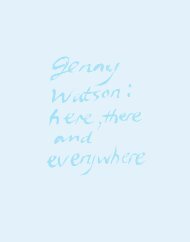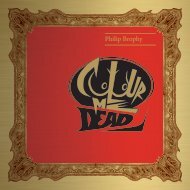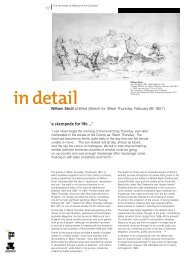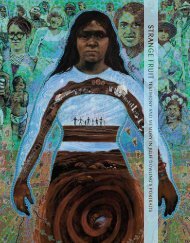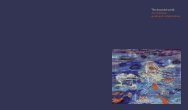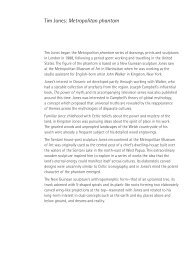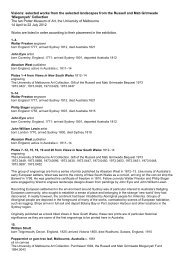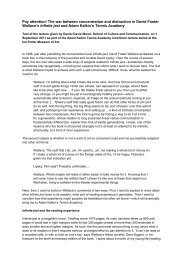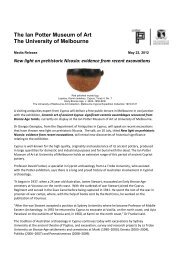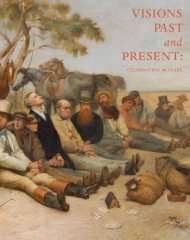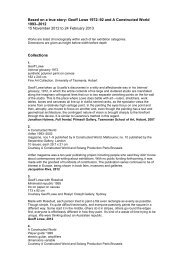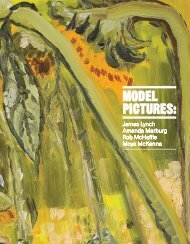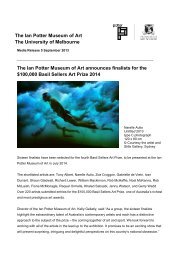Under the sun: the Kate Challis RAKA Award 2013 The Ian Potter ...
Under the sun: the Kate Challis RAKA Award 2013 The Ian Potter ...
Under the sun: the Kate Challis RAKA Award 2013 The Ian Potter ...
- No tags were found...
Create successful ePaper yourself
Turn your PDF publications into a flip-book with our unique Google optimized e-Paper software.
<strong>Under</strong> <strong>the</strong> <strong>sun</strong>: <strong>the</strong> <strong>Kate</strong> <strong>Challis</strong> <strong>RAKA</strong> <strong>Award</strong> <strong>2013</strong><br />
<strong>The</strong> <strong>Ian</strong> <strong>Potter</strong> Museum of Art, <strong>the</strong> University of Melbourne<br />
10 August to 3 November <strong>2013</strong><br />
List of works<br />
Teresa Baker<br />
Pitjantjatjara<br />
born Alice Springs, Nor<strong>the</strong>rn Territory, 1977; lives Kanpi, South Australia<br />
1.<br />
Kalaya 2011<br />
syn<strong>the</strong>tic polymer paint on canvas<br />
<strong>The</strong> Zemaitis Croft Collection, Melbourne<br />
2.<br />
Kalaya Tjukurpa 2011<br />
syn<strong>the</strong>tic polymer paint on canvas<br />
Private collection, Melbourne<br />
3.<br />
Tjukurpa Kutjara 2012<br />
syn<strong>the</strong>tic polymer paint on canvas<br />
Private collection, Melbourne<br />
Teresa Baker paints from her home in <strong>the</strong> settlement of Kanpi, in <strong>the</strong> far north-west of <strong>the</strong> South<br />
Australian desert. Custom and tradition remain strong for Anangu people, and <strong>the</strong> Tjukurpa<br />
(Dreaming) is at <strong>the</strong> core of <strong>the</strong>ir culture and everyday lives. Painting Tjukurpa as a means of<br />
transferring knowledge is a relatively new phenomenon for Anangu—for many thousands of years,<br />
<strong>the</strong>se stories were passed down through story, song and, in some regions, ceremonial dance.<br />
Baker began painting in 2005 under <strong>the</strong> guidance of her artist grandfa<strong>the</strong>r, <strong>the</strong> late Jimmy Baker. <strong>The</strong><br />
two stories, Minyma Malilu and Kalaya Tjukurpa, which are <strong>the</strong> subject of <strong>the</strong>se paintings were taught<br />
to her by her grandfa<strong>the</strong>r. <strong>The</strong> segmentary motifs and irregular fields of dots in Baker’s paintings<br />
create areas that appear to overlap with a dense collage effect that conveys <strong>the</strong> complexity of <strong>the</strong><br />
narratives described. Her paintings capture <strong>the</strong> vastness of <strong>the</strong> desert landscape, replete with areas<br />
of vegetation, water-holes and camp sites.<br />
<strong>The</strong> striking patchwork effect of Baker’s compositions is an innovation in <strong>the</strong> iconography of Western<br />
Desert painting. It shows <strong>the</strong> artist’s confidence, in her mid-thirties, to learn <strong>the</strong> cultural knowledge<br />
and painting style of her grandfa<strong>the</strong>r and present a new and individual visual language.<br />
Daniel Boyd<br />
Kudjla/Gangalu<br />
born Cairns 1982, lives Sydney<br />
4.<br />
Untitled 2012<br />
oil and archival glue on canvas<br />
Private collection, Sydney<br />
5.<br />
Untitled 2012<br />
oil and archival glue on canvas<br />
Collection of <strong>the</strong> Reszka Family Trust, Melbourne<br />
6.<br />
Untitled <strong>2013</strong><br />
oil and archival glue on canvas
Courtesy <strong>the</strong> artist and Roslyn Oxley9 Gallery, Sydney<br />
Daniel Boyd’s ongoing investigations into <strong>the</strong> documentation of Aboriginal cultures by seventeenthand<br />
eighteenth-century explorers took a major turn following his residency at London’s Natural History<br />
Museum in 2011. In a stylistic departure from previous work, Boyd began a series of black and white<br />
paintings—some almost photographic in <strong>the</strong>ir figurative realism, o<strong>the</strong>rs more abstract and<br />
inscrutable—that directly explore <strong>the</strong> colonial past through <strong>the</strong> depiction of historical scenes,<br />
landscapes and artefacts. Boyd’s images are veiled with a textured field of dots, a device that<br />
references <strong>the</strong> early strategies of concealment used by artists of <strong>the</strong> Papunya Tula art movement and<br />
also stands for <strong>the</strong> multiple lenses through which we view history.<br />
<strong>The</strong> works presented here reference Boyd’s ancestry in Vanuatu—specifically <strong>the</strong> colonial slave trade<br />
and <strong>the</strong> fetishisation of so-called ‘primitive cultures’ by modern artists such as Picasso and Matisse.<br />
Boyd offers a reinterpretation of historical situations and events, and engages viewers in a critical<br />
appraisal of assumed histories. That each painting here is untitled is significant and Boyd intentionally<br />
withholds background information for <strong>the</strong>se images. He invites us to contemplate <strong>the</strong> absence of<br />
information and <strong>the</strong> decimation of language and tradition that is <strong>the</strong> legacy of Australia’s colonisation.<br />
Hector Burton<br />
Pitjantjatjara<br />
born Pipalyatjara, west of Amata, South Australia, c. 1937; lives Amata<br />
7.<br />
Punu 2011<br />
syn<strong>the</strong>tic polymer paint on canvas<br />
Private collection, Sydney<br />
8.<br />
Punu-ngura <strong>2013</strong><br />
syn<strong>the</strong>tic polymer paint on canvas<br />
Courtesy <strong>the</strong> artist, Tjala Arts, Amata, South Australia; and Alcaston Gallery, Melbourne<br />
9.<br />
Hector Burton<br />
Pitjantjatjara<br />
born Pipalyatjara, west of Amata, South Australia, c. 1937; lives Amata<br />
Kumanara Wangin<br />
Pitjantjatjara<br />
born Pukutja (Ernabella), South Australia; c. 1939, died Pukutja 2012<br />
Punu-ngura 2011<br />
syn<strong>the</strong>tic polymer paint on canvas<br />
Private collection, Sydney<br />
A senior custodian of Pitjantjatjara law, Hector Burton was among <strong>the</strong> first men in <strong>the</strong> Amata<br />
community to paint following <strong>the</strong> establishment of <strong>the</strong> men’s painting room at Tjala Arts in 2003.<br />
Pitjantjatjara men were initially reluctant to produce paintings for <strong>the</strong> public, not wanting to reveal<br />
sacred spiritual knowledge through this medium. While Burton’s early paintings are formal and<br />
commanding depictions of his creation stories, his recent work reflects a radically different conceptual<br />
basis. Ra<strong>the</strong>r than continuing to pursue aes<strong>the</strong>tic strategies for masking and concealing sacred<br />
designs, Burton adopts a subject he regards as more appropriate for his artistic energy: <strong>the</strong> depiction<br />
of trees.<br />
<strong>The</strong> three paintings displayed here are key works resulting from Burton’s new approach. Pulsing with<br />
colour and life, <strong>the</strong>se paintings represent a proactive stance against <strong>the</strong> revelation of too much<br />
cultural knowledge to outsiders. Placed at <strong>the</strong> centre of <strong>the</strong> composition and depicted from multiple<br />
view-points, <strong>the</strong> trees are shown as fertile, vital forms growing out of water-holes with multiple<br />
branches.
Frank Young, chairman of Tjala Arts, explains: ‘We’re painting <strong>the</strong> outside story in <strong>the</strong>se trees: <strong>the</strong><br />
leaves, <strong>the</strong> branches, <strong>the</strong> stories that spring from <strong>the</strong>m. But <strong>the</strong> secrets beneath <strong>the</strong> trees, <strong>the</strong> root of<br />
<strong>the</strong> story—that we can’t tell’.<br />
Timothy Cook<br />
Tiwi<br />
born Milikapiti, Melville Island, Nor<strong>the</strong>rn Territory, 1958; lives Milikapiti<br />
10.<br />
Kulama 2009<br />
natural pigments and syn<strong>the</strong>tic binder on paper<br />
Collection of Joseph Eisenberg, New South Wales<br />
11.<br />
Kulama 2009<br />
natural pigments and syn<strong>the</strong>tic binder on paper<br />
Collection of Bridget Kennedy, Sydney<br />
12.<br />
Kulama 2012<br />
natural pigments and syn<strong>the</strong>tic binder on paper<br />
Courtesy <strong>the</strong> artist and Aboriginal & Pacific Art, Sydney<br />
13.<br />
Kulama 2012<br />
natural pigments and syn<strong>the</strong>tic binder on paper<br />
Private collection, Perth<br />
14.<br />
Kulama 2012<br />
natural pigments and syn<strong>the</strong>tic binder on paper<br />
<strong>The</strong> Carroll Fairhall Collection, Perth<br />
Working for <strong>the</strong> past thirteen years at <strong>the</strong> Jilamara Arts & Crafts Association in Milikapiti, a town<br />
located on <strong>the</strong> nor<strong>the</strong>rn coastline of Melville Island north of Darwin, Cook is known as a painter of<br />
pukumani poles and, more recently, as a visionary painter of pared-back ochre compositions on paper<br />
and canvas. Tiwi art is characterised by patterning and detail, often displaying motifs embedded<br />
within a repetitive ‘all over’ pattern. Cook chooses instead to focus on a single, key motif in his telling<br />
of <strong>the</strong> important Kulama ceremony.<br />
<strong>The</strong> circular form at <strong>the</strong> centre of Cook’s Kulama paintings represents <strong>the</strong> moon man Japara, one of<br />
<strong>the</strong> main figures of <strong>the</strong> Tiwi creation story (along with his bro<strong>the</strong>r Purukapali, and his bro<strong>the</strong>r’s wife,<br />
Waiyai). Connected to <strong>the</strong> Tiwi mortuary ceremony Pukumani, <strong>the</strong> Kulama ceremony takes place at<br />
<strong>the</strong> end of <strong>the</strong> wet season, to coincide with <strong>the</strong> ripening of <strong>the</strong> yams. Every year, Japara signals that it<br />
is time for <strong>the</strong> ceremony by throwing a visible halo around his moon form. Cook refers to Kulama as<br />
his ‘favourite/special’ subject for painting, describing <strong>the</strong> ceremony as a representation of coming of<br />
age, <strong>the</strong> cycle of life and an initiation into Tiwi kinship.<br />
Mabel Juli<br />
Gija<br />
born Five Mile, south of Warmun, Western Australia, c. 1933; lives Warmun<br />
15.<br />
Garnkeny Ngarranggarni 2010<br />
natural pigments and syn<strong>the</strong>tic binder on canvas<br />
Collection of <strong>the</strong> Daffodil and Daisy Superannuation Fund, Perth<br />
16.<br />
Wardal and Garnkeny 2011<br />
natural pigments and syn<strong>the</strong>tic binder on canvas
Wesfarmers Collection, Perth<br />
17.<br />
Gelenggengayin 2012<br />
natural pigments and syn<strong>the</strong>tic binder on canvas<br />
Collection of Paul Walker and Tricia Mason, Melbourne<br />
Mabel Juli’s paintings deploy a syn<strong>the</strong>sis of horizontal and topographical perspectives—stars and hills<br />
are shown in profile, while o<strong>the</strong>r aspects of <strong>the</strong> land are represented as if from <strong>the</strong> air. Her work is<br />
characteristically minimal; complex narratives are distilled into key iconographic forms. In <strong>the</strong> East<br />
Kimberley region of Western Australia, as in o<strong>the</strong>r areas of Australia, many major geographical sites<br />
are associated with <strong>the</strong> Ngarranggarni (Dreaming) and ancestral beings embodied in country.<br />
A senior artist, ceremonial singer and dancer in <strong>the</strong> Gija community of Warmun, Juli posseses a depth<br />
of cultural knowledge that is reflected in her dedication to <strong>the</strong> detailed process required to paint with<br />
ochre. Sourced locally from beneath <strong>the</strong> ground, ochre is pounded by hand in a mortar and pestle to a<br />
fine powder so it can be mixed with acrylic binder. Juli creates consistent, velvety surfaces by coating<br />
her canvas in multiple layers of ochre pigment. This is highly significant for Juli and all Gija artists; <strong>the</strong><br />
use of ochre for painting reaffirms <strong>the</strong>ir connection to country. It also reflects <strong>the</strong> generosity of Gija<br />
artists—<strong>the</strong>y are sharing not only <strong>the</strong>ir sacred culture with outsiders, but literally <strong>the</strong> country itself.<br />
Kunmarnanya Mitchell<br />
Ngaarnyatjarra<br />
born near Papulankutja (Blackstone), Western Australia, 1943; died Kalgoorlie <strong>2013</strong><br />
18.<br />
Wakalpuka 2012<br />
syn<strong>the</strong>tic polymer paint on canvas<br />
<strong>The</strong> Maclean Collection, Melbourne<br />
19.<br />
Wakalpuka 2011<br />
syn<strong>the</strong>tic polymer paint on canvas<br />
Collection of Nicholas Venet, Melbourne<br />
20.<br />
Wakalpuka 2011<br />
syn<strong>the</strong>tic polymer paint on canvas<br />
<strong>The</strong> Corrigan Collection, Sydney<br />
A senior custodian of Pitjantjatjara law, Hector Burton was among <strong>the</strong> first men in <strong>the</strong> Amata<br />
community to paint following <strong>the</strong> establishment of <strong>the</strong> men’s painting room at Tjala Arts in 2003.<br />
Pitjantjatjara men were initially reluctant to produce paintings for <strong>the</strong> public, not wanting to reveal<br />
sacred spiritual knowledge through this medium. While Burton’s early paintings are formal and<br />
commanding depictions of his creation stories, his recent work reflects a radically different conceptual<br />
basis. Ra<strong>the</strong>r than continuing to pursue aes<strong>the</strong>tic strategies for masking and concealing sacred<br />
designs, Burton adopts a subject he regards as more appropriate for his artistic energy: <strong>the</strong> depiction<br />
of trees.<br />
<strong>The</strong> three paintings displayed here are key works resulting from Burton’s new approach. Pulsing with<br />
colour and life, <strong>the</strong>se paintings represent a proactive stance against <strong>the</strong> revelation of too much<br />
cultural knowledge to outsiders. Placed at <strong>the</strong> centre of <strong>the</strong> composition and depicted from multiple<br />
view-points, <strong>the</strong> trees are shown as fertile, vital forms growing out of water-holes with multiple<br />
branches. Frank Young, chairman of Tjala Arts, explains: ‘We’re painting <strong>the</strong> outside story in <strong>the</strong>se<br />
trees: <strong>the</strong> leaves, <strong>the</strong> branches, <strong>the</strong> stories that spring from <strong>the</strong>m. But <strong>the</strong> secrets beneath <strong>the</strong> trees,<br />
<strong>the</strong> root of <strong>the</strong> story—that we can’t tell’.<br />
Alick Tipoti<br />
Kala Lagaw Ya
Argan and Wakaid clans<br />
born Badu (Mulgrave) Island, Torres Strait, 1975; lives Cairns and Badu Island<br />
21.<br />
Mawa (Dhanga moelpal) 2010<br />
fibreglass resin, syn<strong>the</strong>tic polymer paint, fea<strong>the</strong>rs, raffia, beads, shell, wood, bamboo, plastic<br />
Courtesy <strong>the</strong> artist and <strong>the</strong> Australian Print Network, Sydney<br />
22.<br />
Maza mawa wapiya 2011<br />
fibreglass resin, fea<strong>the</strong>rs, beads, twine<br />
Courtesy <strong>the</strong> artist<br />
23.<br />
Solal mawa 2011<br />
fibreglass resin, fea<strong>the</strong>rs, beads, twine<br />
Courtesy <strong>the</strong> artist<br />
24.<br />
Koedal augadhalaig 2011<br />
fibreglass, resin, fea<strong>the</strong>rs, beads, twine<br />
Courtesy <strong>the</strong> artist and Gallery Gabrielle Pizzi, Melbourne<br />
Alick Tipoti is one of <strong>the</strong> most recognised printmakers and sculptors of <strong>the</strong> Torres Strait Islands. <strong>The</strong><br />
four major sculptures here relate to traditional Mawa masks. Mawa masks are worn by Torres Strait<br />
Islanders during ceremonies that are connected to life, death and magic. Mawa literally translates as<br />
‘sorcerer’ or ‘medicine man’. Tipoti draws inspiration from <strong>the</strong> ancient artefacts he has accessed in<br />
various university and museum collections in Australia and overseas, as well as from traditional<br />
stories handed down from <strong>the</strong> elders of <strong>the</strong> Torres Strait.<br />
Historically, unnamed artists carved Mawa masks from turtle shell, decorating <strong>the</strong>m with fea<strong>the</strong>rs,<br />
shells, seeds, human hair and o<strong>the</strong>r natural materials. In his Cairns studio, Tipoti uses modern<br />
materials and techniques in a practice which he believes to be guided by his spiritual ancestors, <strong>the</strong><br />
Zugubal. <strong>The</strong>se arresting sculptures embody Tipoti’s successful straddling of two realms—<strong>the</strong><br />
contemporary and <strong>the</strong> customary. <strong>The</strong> masks’ powerful evocation of sacred aspects of traditional<br />
Torres Strait culture is matched by <strong>the</strong> unmistakably contemporary nature of <strong>the</strong>ir materials and scale.<br />
Garawan Wanambi<br />
Yolngu<br />
Dhuwa moiety, Marrakulu clan<br />
born Gangan, East Arnhem Land, Nor<strong>the</strong>rn Territory, 1965; lives Gangan<br />
25.<br />
Marrangu 2010<br />
natural pigments and syn<strong>the</strong>tic binder on hollow stringy bark log<br />
Private collection, Melbourne<br />
26.<br />
Marrangu 2010<br />
natural pigments and syn<strong>the</strong>tic binder on hollow stringy bark log<br />
Courtesy <strong>the</strong> artist and Niagara Galleries, Melbourne<br />
27.<br />
Marrangu 2012<br />
natural pigments and syn<strong>the</strong>tic binder on hollow stringy bark log<br />
Collection of Chris and Nada Kazantzidis, Melbourne<br />
28.<br />
Marrangu 2009<br />
natural pigments and syn<strong>the</strong>tic binder on hollow stringy bark log
<strong>The</strong> Andrew Penn and Kallie Blauhorn Collection, Melbourne<br />
29.<br />
Marrangu <strong>2013</strong><br />
natural pigments and syn<strong>the</strong>tic binder on bark<br />
Courtesy <strong>the</strong> artist, Buku-Larrnggay Mulka Centre, Nor<strong>the</strong>rn Territory; and Niagara Galleries,<br />
Melbourne<br />
<strong>The</strong> system of classification that underpins North-east Arnhem Land social life is integral to <strong>the</strong> art<br />
produced by <strong>the</strong> Yolngu people. <strong>The</strong> land is divided into areas held by clans, and clans are classed as<br />
belonging to one of two moieties, Dhuwa or Yirritja. Yolngu painting is characterised by an elaborate<br />
system of designs which reflect <strong>the</strong> different relationships of various clans with <strong>the</strong>ir ancestors and<br />
land. <strong>The</strong> title of <strong>the</strong>se works, Marrangu, refers to <strong>the</strong> clan into which Wanambi was adopted when his<br />
fa<strong>the</strong>r passed away.<br />
<strong>The</strong> central image of Wanambi’s larrakitj (hollow log) design represents, among o<strong>the</strong>r things, <strong>the</strong><br />
ancestral tree after which Wanambi is named, a stone spearhead from Ngilibidji, and <strong>the</strong> pointed stick<br />
used by Yolngu to lance boils. <strong>The</strong> geometric designs and cross-hatching represent a place in <strong>the</strong><br />
river mouth near Raymangirr in East Arnhem Land, where <strong>the</strong> currents of fresh and salt water mingle<br />
and surge around <strong>the</strong> rocks in his clan country. Wanambi communicates <strong>the</strong> drama of this moving,<br />
dynamic body of water by introducing subtle shifts in <strong>the</strong> formal, diamond-shaped repetitive designs in<br />
his work. <strong>The</strong>se skilful, sometimes barely perceptible adjustments create absorbing visual effects; <strong>the</strong><br />
rhythms of <strong>the</strong> designs become unpredictable, melding forms toge<strong>the</strong>r and creating purely optical<br />
boundaries between what might be foreground or background.<br />
Regina Pilawuk Wilson<br />
Ngan’gikurrunggurr<br />
born Daly River region, Nor<strong>the</strong>rn Territory, 1948; lives Peppimenarti, Nor<strong>the</strong>rn Territory<br />
30.<br />
Warrgadi [Dilly bag] 2011<br />
syn<strong>the</strong>tic polymer paint on canvas<br />
Courtesy <strong>the</strong> artist and Durrmu Arts, Peppimenarti, Nor<strong>the</strong>rn Territory<br />
31.<br />
Sun mat <strong>2013</strong><br />
pandanus, sand palm and natural dyes<br />
Courtesy <strong>the</strong> artist and Durrmu Arts, Peppimenarti, Nor<strong>the</strong>rn Territory<br />
32.<br />
Syaw [Fish net] 2009<br />
syn<strong>the</strong>tic polymer paint on canvas<br />
Courtesy <strong>the</strong> artist, Durrmu Arts, Peppimenarti, Nor<strong>the</strong>rn Territory; and Michael<br />
Reid, Sydney<br />
<strong>The</strong> subject matter of Regina Pilawuk Wilson’s paintings derives from various weaving techniques she<br />
was taught by her mo<strong>the</strong>r and grandmo<strong>the</strong>r as a young girl. Since she began painting in 2000, Wilson<br />
has developed a sophisticated process of transferring traditional designs used in <strong>the</strong> making of woven<br />
fibre objects including syaw (fish net) and warrgadi (dilly bag) onto canvas. A skilled weaver, Wilson<br />
applies her rich knowledge of colour, line and texture to painting <strong>the</strong> delicate and variegated lines that<br />
suggest interwoven textures in <strong>the</strong> paintings Syaw and Warrgadi.<br />
Wilson extends <strong>the</strong> creative possibilities of traditional weaving in her brightly hued, iconic Sun mat.<br />
Flat, circular mats (which now hang on <strong>the</strong> walls of Australian museums and galleries) have evolved<br />
out of a tradition of utilitarian mats that are made in areas of <strong>the</strong> Nor<strong>the</strong>rn Territory, including <strong>the</strong> Daly<br />
River region and Arnhem Land, where <strong>the</strong> pandanus tree flourishes. Collecting <strong>the</strong> natural materials<br />
in <strong>the</strong> heat is physically demanding work. In contrast, stripping and dying <strong>the</strong> pandanus, and <strong>the</strong>n<br />
tightly coiling it by hand, is a slow, meditative and sometimes social act. <strong>The</strong> perseverance and<br />
patience required for weaving is reflected in <strong>the</strong> fine, repetitive mark-making of Wilson’s paintings.



